Open Access, Peer-reviewed
eISSN 2093-9752

Open Access, Peer-reviewed
eISSN 2093-9752
Sunghe Ha
Inje Lee
Joo-Nyeon Kim
https://dx.doi.org/10.5103/KJAB.2023.33.3.85 Epub 2023 September 01
Abstract
Objective: This study examined differences in joint kinematics and movement variability of lower extremity between adolescent athletes with and without lateral ankle sprain (LAS) history during drop vertical jump.
Method: Fourteen adolescent athletes with LAS history and 14 controls participated in this study. The independent variable was group while dependent variables were 3D joint kinematics and movement variability of hip, knee, and ankle joint. Ensemble curve analyses were conducted to identify differences in movement strategies between two groups.
Results: The LAS group showed that greater eversion during jump phase compared with the control group. Additionally, less movement variability was found in the LAS group during the pre-landing and jump phases in ankle and hip joints compared with the control group.
Conclusion: The LAS group may adapt the environmental constraints by reducing the movement variability in ankle and hip joints. However, training programs focusing on recovery of ankle function should be emphasized after LAS because excessive pronation for prevention of LAS during the jump phase may result in reduced performance.
Keywords
Biomechanics Kinematics Landing Sports injury Time-series analysis Youth
가쪽 발목 염좌는 체중이 지지된 상태에서 발뒤부(rear foot)의 과도한 뒤침(supination)으로 인하여 발생된 발목관절 주변조직의 손상으로 정의된다(Hertel & Corbett, 2019). 아동의 발목 염좌 발생률은 유소년보다 높고, 유소년이 성인보다 높게 보고된다(Doherty et al., 2014; Ha, Lee & Lee, 2021). 발목 염좌 이후 착지 및 점프 동작에서 하지관절의 운동학적 차이가 보고되었으며(Brown, Padua, Marshall & Guskiewicz, 2011; Doherty et al., 2015b; Terada & Gribble, 2015), 이는 재부상 또는 만성 발목 불안정성(chronic ankle instability)을 유발하는 위험요인으로 작용하는 것으로 나타났다(Hertel & Corbett, 2019; Roos et al., 2017; Yeung, Chan, So & Yuan, 1994). 또한 발목 염좌를 경험한 사람은 그렇지 않은 사람 보다 발목 골관절염(osteoarthritis)으로 진행될 확률이 46% 높은 것으로 보고되었다(Lee, Song & Lee, 2022). 만약 유소년시기에 발목 염좌를 경험한다면 20대에 발목 골관절염이 발병할 수 있으며 이로 인해 선수는 스포츠 경력 중단의 위험에 노출될 수 있다(Ha et al., 2021).
착지 점프(Drop vertical jump)는 착지 시 충격을 흡수하는 움직임과 점프 시 충격을 발생시키는 움직임 관찰을 통해 신경근 제어를 평가할 수 있는 동작이다(Hewett et al., 2005). 착지 동작은 발목 염좌가 나타나는 주요한 기전 중 하나로 보고되고 있으나(Herb, Blemker, Saliba, Hart & Hertel, 2020; Theisen & Day, 2019), 보행연구(Lee, Ha, Chae, Jeong & Lee, 2022; Lee & Park, 2020) 및 동적균형연구(Doherty et al., 2015a)에 비해 미흡한 실정이다. 또한 대부분이 성인을 대상으로 한 연구이며, 유소년을 대상으로 발목 염좌와 착지 점프 동작을 분석한 연구는 부족한 상황으로 판단된다.
같은 동작을 반복할 때 유사한 형태를 띄지만 완벽히 동일한 움직임을 재현할 수 없다. 한 사람이 동일한 동작을 여러 번 반복 수행할 때 나타나는 정상적 변화를 움직임 가변성(movement variability)이라고 한다(Stergiou & Decker, 2011). 근골격계 손상은 조직의 물리적 변화로 인한 기계적 불안정성과 고유수용감각 상실로 인한 기능적 불안정성이 유발될 수 있는데(Courtney, Rine & Kroll, 2005), 불안정성이 높아진 인체는 안전한 움직임을 위해 유연성 감소 및 경직된 움직임을 취하며 움직임 가변성을 최소화하게 된다(Stergiou & Decker, 2011). 이렇게 감소된 움직임은 동일한 관절 표면에 지속적으로 부하를 가하게 되어 조직의 손상 또는 관절의 퇴행을 초래할 수 있다(Fithian, Paxton & Goltz, 2002; Owoeye et al., 2021).
스포츠 상황에서 예측할 수 없는 상황이 발생하면 동일한 결과를 만들기 위해 움직임의 가변성을 증가시키는 것으로 나타났다(Legg, Pyne, Semple & Ball, 2017). 그러나 과도한 운동 변동성은 익숙하지 않은 움직임으로 인해 자세를 제어할 수 없어 부정적 보상에 의한 급성 부상을 유발할 수 있다(Brach, Berlin, VanSwearingen, Newman & Studenski, 2005; Cignetti, Schena & Rouard, 2009; Ryew, Hyun & Kim, 2016). 선행연구 결과를 종합해보면 기존 움직임 가변성의 과도한 증가 및 감소는 새로운 부상의 위험요인으로 작용할 수 있으므로 발목 염좌를 경험한 유소년 운동선수의 움직임 패턴과 가변성 관찰을 통해 발목 염좌 이후 변화된 움직임을 이해할 필요가 있다.
따라서 본 연구의 목적은 발목 염좌 경험이 있는 유소년 운동선수의 착지 및 점프 동작 시 하지관절의 운동학과 가변성을 관찰하고 발목 염좌 경험이 없는 통제집단과의 차이를 관찰하는데 있다. 본 연구의 가설은 다음과 같다: 1) 발목 손상집단과 통제집단의 착지 및 점프 전략은 차이가 나타날 것이다; 2) 발목 손상집단과 통제집단의 하지관절의 가변성은 차이가 나타날 것이다.
1. 연구대상자
본 연구를 위해 발목 손상 경험이 있는 유소년 운동선수(group of lateral ankle sprain history, LAS 집단) 14명(나이: 14.1±1.0 yrs, 키: 166.2±10.1 cm, 몸무게: 59.7±9.2 kg)과 통제집단(control group)은 14명(나이: 13.7±0.9 yrs, 키: 164.2±6.4 cm, 몸무게: 54.1±6.7 kg)이 모집되었다. LAS 집단은 가쪽 발목 염좌 병력이 있는 선수로 선정하였으며 통제집단은 가쪽 발목 염좌가 없는 선수를 선정하였다. 두 집단 모두 최근 3개월 내 근골격계 손상이 없는 선수로 한정하였다. 연구 수행 전 생명윤리위원회 승인(KISS-21018-2111-04)을 받았고, 모든 대상자의 자발적 동의 후 진행되었다.
2. 연구절차
모든 대상자는 착지 및 점프 동작의 3차원 동작분석을 위해 상 · 하의 타이즈를 착용하고 개인 운동화를 착용하였다. 이후 하체를 7개 분절로 모델링하기 위해 양쪽 위앞엉덩뼈가시, 엉덩뼈가시, 위뒤엉덩뼈가시, 큰돌기, 넙다리, 뒤넙다리, 무릎 가쪽위관절융기, 무릎 안쪽위관절융기, 정강이뼈거친면, 가쪽복사, 안쪽복사, 첫 번째 발허리뼈머리, 다섯 번째 발허리뼈머리, 발가락, 발꿈치뼈에 마커(marker)를 부착하였다.
본 연구 대상자는 착지 및 점프 동작을 수행하기 전 준비운동과 연습 시간을 제공받았다. 이 후 30 cm 박스 위에서 시작하여 각 대상자 키의 50% 지점에 착지 후 곧바로 수직 점프를 수행하도록 요청되었다(Welling, Benjaminse, Gokeler & Otten, 2016). 착지지점에 못 들어오거나 다른 방향으로 수직 점프가 수행된 경우를 제외하고 5회의 동작을 수집하였다(Nordin & Dufek, 2017). 동작 수행 시 피로의 영향을 최소화하기 위해 대상자의 요청이 있는 경우와 1회 수행 후 충분한 휴식을 제공하였다.
3. 자료처리
운동학적 자료는 Oqus700+ 적외선 카메라(Qualisys, Sweden) 20대를 사용하였고 샘플링율은 250 Hz로 수집되었다. 수집된 자료는 Visual 3D (C-motion, USA) 소프트웨어를 사용하여 노이즈 제거를 위해 Butterworth Bidirectional low-pass filter를 차단주파수 6 Hz로 실시하였다. 발목, 무릎, 엉덩관절의 3차원 각도는 각 구간 별 시간으로 표준화하여 분석하였다. 본 연구에서는 다음과 같이 3구간에서의 하지관절각과 가변성을 분석하였다: 1) 착지 전 구간(pre-landing phase)은 착지 전 50 ms에서 발이 지면에 닿기 시작하는 시점까지; 2) 착지 구간(landing phase)은 발이 지면에 닿기 시작하는 시점에서 무릎 굽힘각이 최대인 시점까지; 3) 점프 구간(push-off phase)은 무릎 굽힘각이 최대인 시점에서 발이 지면에서 떨어지는 시점까지 Figure 2. Results of ensemble curve analyses on movement pattern between lateral ankle sprain (red) and control groups (blue) during pre-landing phase of drop vertical jump (mean ± 95% confidence interval). Gray boxes indicate significantly different intervals between groups on movement variability. Abbreviations: ABD, abduction; ADD, adduction; CON, control; CV,coefficient of variance; DF, dorsiflexion; ER, external rotation; EV, eversion; EXT, extension; FLEX, flexion; IN, inversion;IR, internal rotation; LAS, lateral ankle sprain; PF, plantar flexion; VAL, valgus; VAR, varus. (Figure 1). 가변성은 표준편차(standard deviation)를 평균(mean)으로 표준화한 변동계수(coefficient of variation, [%CV])를 산출하였다(Nordin & Dufek, 2019). 각정의는 엉덩관절 굽힘(flexion), 모음(adduction), 안쪽돌림(internal rotation), 무릎관절 굽힘, 밖굽이(valgus), 가쪽돌림, 발목관절 발등굽힘(dorsi- flexion), 가쪽번짐(eversion), 벌림을 양의 방향으로 설정하였다.

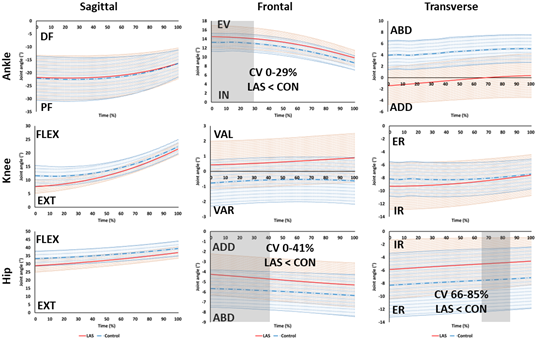
4. 통계처리
본 연구에서 독립변수는 집단이었으며 3차원 하지관절각도 및 가변성을 종속변수로 사용하였다. 집단 간 시계열데이터(time-series data)의 차이를 검증하기 위해 앙상블 커브 분석(ensemble curve analysis)을 수행하였으며, 각 집단의 평균 및 95% 신뢰구간을 산출하여 95% 신뢰구간이 겹치지 않는 구간을 유의한 차이가 있다고 정의하였다(Lee et al., 2022). 본 연구의 통계처리는 Excel365 (Microsoft, USA)를 통해 수행하였다.
집단 간 하지관절각도의 차이를 분석한 결과, 점프 구간의 94~100% 동안 LAS 집단이 통제집단보다 더 큰 가쪽번짐된 움직임 패턴을 보였고(Figure 4), 그 외 다른 관절과 운동면에서 유의한 움직임 패턴 차이는 관찰되지 않았다(Figure 2-4).
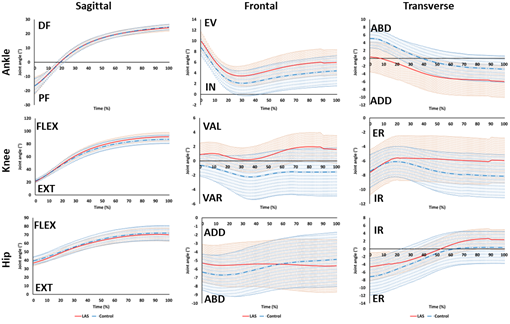
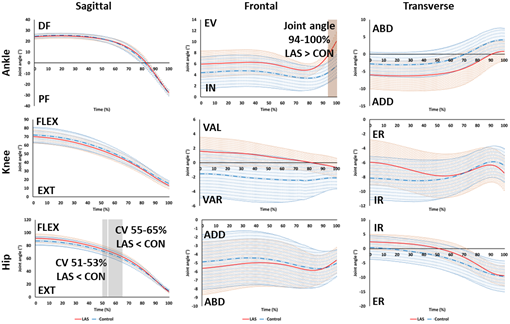
집단 간 가변성 차이에 대한 앙상블 곡선 분석 결과, LAS 집단은 통제집단보다 착지 전 구간의 0~29% 동안 발목의 이마면, 0~41% 동안 엉덩관절의 이마면과 66~85% 동안 엉덩관절의 수평면에서 유의하게 작은 가변성을 보여주었다(Appendix 1). 또한, 점프 구간의 51~53% 및 55~65% 동안 LAS 집단에서 통제집단보다 엉덩관절의 작은 시상면 가변성이 관찰되었다(Appendix 3). 그 외 다른 관절과 운동면에서 유의한 가변성 차이는 관찰되지 않았다(Appendix 1-3).
본 연구는 발목 염좌 경험이 있는 유소년 운동선수의 착지 및 점프 동작 시 하지관절의 운동학과 가변성을 관찰하고 발목 염좌 경험이 없는 통제집단과의 차이를 분석하였다.
두 집단 모두 착지 전 발목관절을 가쪽번짐으로 정렬하는 경향이 관찰되었고, 착지 전 구간에서 LAS 집단의 이마면 발목관절 가변성이 통제집단보다 작은 것으로 관찰되었다. 선행연구에 따르면 만성 발목 불안정성이 있는 성인의 경우 착지 시 통제집단과 발목관절 움직임의 차이는 없었으나 움직임 변동성의 감소가 나타난 것으로 보고되었다(Brown, Bowser & Simpson, 2012). 가쪽 발목 염좌는 체중부하가 된 상태에서 발생하기 때문에 체중부하가 발생하기 이전인 착지 전 구간에서의 움직임이 착지 후 신체 안정성에 영향을 미칠 수 있다. 보행 중 비체중부하 상태인 체공기(swing phase)에서 발목관절의 안쪽번짐 관절위치감각(joint position sense) 인지저하는 지속적인 가쪽 발목 염좌의 위험을 증가시킬 수 있다고 보고된다(Konradsen & Voigt, 2002). 움직임 가변성의 증가는 동작 수행과 환경적 제약에 적응할 수 있는 효과적인 방안을 모색할 수 있도록 하지만(Brown et al., 2012), 만성 발목 불안정성이 있는 사람의 경우 부상 경험으로 인한 감각수용기의 결함을 경험하므로 위험한 자세를 피하기 위해 움직임 가변성을 감소시킬 수 있다. 본 연구에서 LAS 집단은 통제집단과 같은 가쪽번짐 상태로 착지를 준비하였으나 환경적 변화에 적응하는 능력이 저하된 상태이기 때문에 안전한 착지를 위한 착지 전 가변성 감소 전략을 사용한 것으로 생각된다.
과제에 적응하기 위해 대상자들은 특정관절의 움직임 가변성을 증가시키거나 감소시킴으로써 과제를 수행하게 된다(Davids, Glazier, Araújo & Bartlett, 2003). 본 연구 결과, LAS 집단의 착지 전 구간 중 엉덩관절 이마면 및 수평면의 움직임 가변성이 통제집단보다 작게 나타났고, 점프 구간 중 엉덩관절 시상면 움직임 가변성 감소가 관찰되었다. 본 연구의 LAS 집단은 효과적인 움직임 전략 구사 시 다양성을 감소시키는 것으로 관찰되었는데 시간적 순서를 고려하면 착지 전 구간 중 발목의 이마면, 엉덩관절의 이마면, 그리고 엉덩관절의 수평면 움직임 가변성 감소로 이어졌다. 선행연구에 따르면 운동사슬(kinetic chain)적 관점에서 발목의 기능부전은 몸쪽 관절 보상(proximal joint compensation)을 야기한다(DeJong, Koldenhoven & Hertel, 2020). 만성 발목 불안정성이 있는 사람에게서 착지 점프 동작 수행 시 엉덩관절 운동학적 변화 및 가쪽돌림, 벌림, 폄 근육의 근력이 저하가 관찰되었다(DeJong et al., 2020). 따라서 본 연구에서 관찰된 착지 전 구간의 움직임 가변성 변화는 발목의 기능부전이 발목뿐 아니라 엉덩관절의 가변성까지 감소시켰고 특히 발목 염좌와 관계가 있는 이마면(발목 안쪽번짐)과 수평면(발목 모음)에서 통제함으로써 뻣뻣한 착지 전략을 수행한 것으로 생각된다. 점프 구간 중 관찰된 엉덩관절 시상면 움직임 가변성 감소는 스쿼트(squat) 동작 시 하강 및 상승 구간에 따라 관절의 기여도 차이로부터 기인했을 수 있다(Armstrong et al., 2022). 하강 구간에서는 무릎관절이 엉덩관절보다 큰 기여도를 보이는 반면, 상승 구간에서는 반대의 패턴이 확인되었다. 따라서 수직 점프와 같은 상승 구간에서는 엉덩관절의 기여도가 중요하다. 그러나 LAS 그룹의 경우 환경적 제약에 대처하는 능력이 부족함으로 점프 시 내부적 환경의 변화를 통제하고자 가변성을 감소시킨 것으로 생각된다.
본 연구의 LAS 집단은 점프 구간의 말기(94~100%)에서 통제집단보다 큰 발목의 가쪽번짐 패턴을 보여주었다. 발목은 사선축(oblique axis)으로 인해 단평면(uniplanar) 동작이 아닌 다평면(multiplanar) 동작을 수행하게 된다(Hertel, 2002). 따라서 엎침(pronation)은 발등굽힘, 가쪽번짐, 벌림이 동시 발생하며 일어나고, 뒤침은 발바닥굽힘, 안쪽번짐, 모음이 함께 발생하는 동작으로 정의된다. 따라서 점프 구간에서 과도한 엎침은 효율적이지 못한 점프 수행 전략일 수 있다. 만성 발목 불안정성이 있는 대학생은 통제집단에 비해 유의하게 낮은 점프 수행능력을 보여주었다(Buchanan, Docherty & Schrader, 2008). 점프 구간 말기의 과도한 엎침 패턴이 반복되는 가쪽 발목 염좌를 예방하기 위한 전략일지라도 운동 수행능력의 저하가 발생될 수 있다는 점을 고려하면 손상 후 발목 기능 회복에 대한 재활 및 컨디셔닝 훈련의 필요성이 강조될 필요가 있다.
본 연구의 주요 결과로 다음과 같은 특성이 관찰되었다. 1) 발목관절의 이마면에서 LAS 집단은 통제집단보다 작은 가변성을 보였다. 2) 엉덩관절의 세 평면에서 LAS 집단은 통제집단보다 작은 가변성을 보였다. 3) LAS 집단은 점프 구간 말기에서 통제집단보다 큰 발목의 가쪽번짐 움직임을 보였다.
LAS 집단은 통제집단에 비해 발목과 엉덩관절에서 움직임 가변성을 감소시킴으로써 환경적 제약에 대한 대응을 한 것으로 보인다. 그러나 점프 구간에서 손상 예방을 위한 발목의 과도한 엎침 형태가 운동수 행능력의 저하를 야기할 수 있기 때문에 가쪽 발목 염좌 후 발목 기능 회복을 위한 훈련의 중요성이 강조되어야 한다.
본 연구를 수행함에 있어 다음과 같은 제한점이 있었다. 첫째, 표본수가 적어서 일반화 및 통계적 유의성을 관찰하는 데 제한이 있었다. 둘째, 환자-대조군 연구(case-control study) 설계로 인해 움직임 가변성과 가쪽 발목 염좌 간 인과관계를 제시할 수 없다. 셋째, 본 연구에서는 운동학적 변인에 대한 분석만 수행되었을 뿐, 운동역학적 및 근활성도에 대한 비교는 수행되지 않아 전체적인 움직임 전략에 대해 설명하는 데 제한이 있다. 따라서 본 연구의 제한점을 보완하기 위해 많은 표본수를 대상으로 전향적 연구를 수행한다면 움직임 가변성과 손상간 인과관계 제시 및 통계적 유의성에 의미를 부여할 수 있을 것이다.
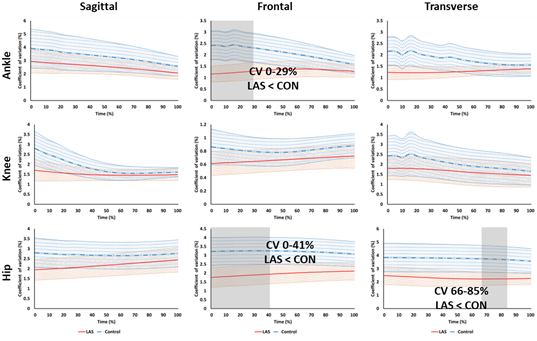
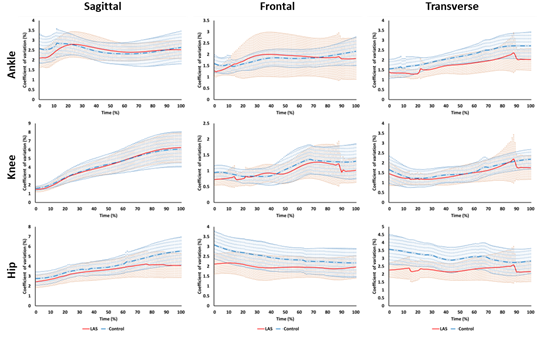
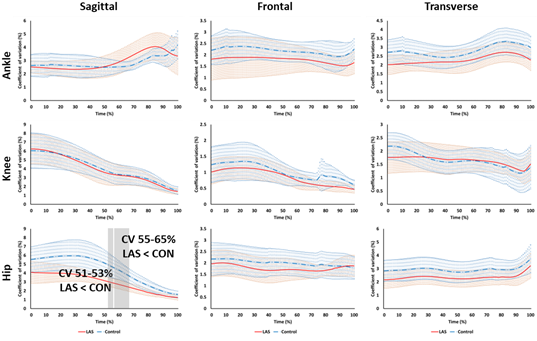
References
1. Armstrong, R., Baltzopoulos, V., Langan-Evans, C., Clark, D., Jarvis, J., Stewart, C. & O'Brien, T. (2022). Kinetics, kine- matics and muscle activation during eccentric squatting. Proceedings of the ISBS Conference 2022. Liverpool, UK.
Google Scholar
2. Brach, J. S., Berlin, J. E., VanSwearingen, J. M., Newman, A. B. & Studenski, S. A. (2005). Too much or too little step width variability is associated with a fall history in older persons who walk at or near normal gait speed. Journal of Neuroengineering and Rehabilitation, 2(1), 1-8.
Google Scholar
3. Brown, C., Bowser, B. & Simpson, K. J. (2012). Movement vari- ability during single leg jump landings in individuals with and without chronic ankle instability. Clinical Biomechanics, 27(1), 52-63.
Google Scholar
4. Brown, C. N., Padua, D. A., Marshall, S. W. & Guskiewicz, K. M. (2011). Hip kinematics during a stop-jump task in patients with chronic ankle instability. Journal of Athletic Training, 46(5), 461-467.
Google Scholar
5. Buchanan, A. S., Docherty, C. L. & Schrader, J. (2008). Functional performance testing in participants with functional ankle instability and in a healthy control group. Journal of Athletic Training, 43(4), 342-346.
Google Scholar
6. Cignetti, F., Schena, F. & Rouard, A. (2009). Effects of fatigue on inter-cycle variability in cross-country skiing. Journal of Biomechanics, 42(10), 1452-1459.
Google Scholar
7. Courtney, C., Rine, R. M. & Kroll, P. (2005). Central somato- sensory changes and altered muscle synergies in subjects with anterior cruciate ligament deficiency. Gait & Posture, 22(1), 69-74.
Google Scholar
8. Davids, K., Glazier, P., Araújo, D. & Bartlett, R. (2003). Movement systems as dynamical systems: The functional role of variability and its implications for sports medicine. Sports Medicine, 33(4), 245-260.
Google Scholar
9. DeJong, A. F., Koldenhoven, R. M. & Hertel, J. (2020). Proximal adaptations in chronic ankle instability: Systematic review and meta-analysis. Medicine and Science in Sports and Exercise, 52(7), 1563-1575.
Google Scholar
10. Doherty, C., Bleakley, C., Hertel, J., Caulfield, B., Ryan, J. & Delahunt, E. (2015a). Dynamic balance deficits 6 months following first-time acute lateral ankle sprain: A laboratory analysis. Journal of Orthopaedic & Sports Physical Therapy, 45(8), 626-633.
Google Scholar
11. Doherty, C., Bleakley, C., Hertel, J., Caulfield, B., Ryan, J. & Delahunt, E. (2015b). Single-leg drop landing motor control strategies following acute ankle sprain injury. Scandinavian Journal of Medicine & Science in Sports, 25(4), 525-533.
Google Scholar
12. Doherty, C., Delahunt, E., Caulfield, B., Hertel, J., Ryan, J. & Bleakley, C. (2014). The incidence and prevalence of ankle sprain injury: A systematic review and meta-analysis of prospective epidemiological studies. Sports Medicine, 44, 123-140.
Google Scholar
13. Fithian, D. C., Paxton, L. W. & Goltz, D. H. (2002). Fate of the anterior cruciate ligament-injured knee. Orthopedic Clinics, 33(4), 621-636.
Google Scholar
14. Ha, S., Lee, S. Y. & Lee, I. (2021). A survey on management of severe ankle sprain in recreational and elite athletes. The Korean Journal of Sport, 19(3), 685-693.
15. Herb, C. C., Blemker, S., Saliba, S., Hart, J. & Hertel, J. (2020). Chronic ankle instability patients exhibit higher variability in lower extremity joint-coupling variability during drop vertical jumps. Journal of Biomechanics, 99, 109479.
Google Scholar
16. Hertel, J. (2002). Functional anatomy, pathomechanics, and pathophysiology of lateral ankle instability. Journal of Athletic Training, 37(4), 364-375.
Google Scholar
17. Hertel, J. & Corbett, R. O. (2019). An updated model of chronic ankle instability. Journal of Athletic Training, 54(6), 572-588.
Google Scholar
18. Hewett, T. E., Myer, G. D., Ford, K. R., Heidt Jr, R. S., Colosimo, A. J., McLean, S. G., van den Bogert, A. L., Paterno, M. V. & Succop, P. (2005). Biomechanical measures of neuro- muscular control and valgus loading of the knee predict anterior cruciate ligament injury risk in female athletes: A prospective study. The American Journal of Sports Medicine, 33(4), 492-501.
Google Scholar
19. Konradsen, L. & Voigt, M. (2002). Inversion injury biomechanics in functional ankle instability: a cadaver study of simulated gait. Scandinavian Journal of Medicine & Science in Sports, 12(6), 329-336.
Google Scholar
20. Lee, I., Ha, S., Chae, S., Jeong, H. S. & Lee, S. Y. (2022). Altered biomechanics in individuals with chronic ankle instability compared with copers and controls during gait. Journal of Athletic Training, 57(8), 760-770.
Google Scholar
21. Lee, M. & Park, J. (2020). Effects of vibration exercise on lower segment movements and gait abilities in chronic ankle instability (CAI) female athletes. Journal of Korean Association of Physical Education and Sport for Girls and Women, 34(4), 155-170.
22. Lee, S., Song, K. & Lee, S. Y. (2022). Epidemiological study of post-traumatic ankle osteoarthritis after ankle sprain in 195,393 individuals over middle age using the National Health Insurance Database: A retrospective design. Journal of Science and Medicine in Sport, 25(2), 129-133.
Google Scholar
23. Legg, J., Pyne, D. B., Semple, S. & Ball, N. (2017). Variability of jump kinetics related to training load in elite female basketball. Sports, 5(4), 85.
Google Scholar
24. Nordin, A. D. & Dufek, J. S. (2017). Lower extremity variability changes with drop-landing height manipulations. Research in Sports Medicine, 25(2), 144-155.
Google Scholar
25. Nordin, A. D. & Dufek, J. S. (2019). Reviewing the variability-overuse injury hypothesis: Does movement variability relate to landing injuries?. Research Quarterly for Exercise and Sport, 90(2), 190-205.
Google Scholar
26. Owoeye, O., Whittaker, J., Toomey, C., Räisänen, A., Jaremko, J. & Emery, C. (2021). Outcomes related to posttraumatic osteoarthritis after a youth sport related ankle sprain. Osteoarthritis and Cartilage, 29, S294.
27. Roos, K. G., Kerr, Z. Y., Mauntel, T. C., Djoko, A., Dompier, T. P. & Wikstrom, E. A. (2017). The epidemiology of lateral ligament complex ankle sprains in National Collegiate Athletic Association sports. The American Journal of Sports Medicine, 45(1), 201-209.
Google Scholar
28. Ryew, C., Hyun, S. & Kim, Y. (2016). Effects of vertical jump performance and ground reation force variables according to the fatigue by submaximal treadmill exercise. Kinesi- ology, 18(3), 1-11.
Google Scholar
29. Stergiou, N. & Decker, L. M. (2011). Human movement vari- ability, nonlinear dynamics, and pathology: is there a con- nection?. Human Movement Science, 30(5), 869-888.
Google Scholar
30. Terada, M. & Gribble, P. A. (2015). Jump landing biomechanics during a laboratory recorded recurrent ankle sprain. Foot & Ankle International, 36(7), 842-848.
Google Scholar
31. Theisen, A. & Day, J. (2019). Chronic ankle instability leads to lower extremity kinematic changes during landing tasks: A systematic review. International Journal of Exercise Science, 12(1), 24.
Google Scholar
32. Welling, W., Benjaminse, A., Gokeler, A. & Otten, B. (2016). Enhanced retention of drop vertical jump landing tech- nique: A randomized controlled trial. Human Movement Science, 45, 84-95.
Google Scholar
33. Yeung, M. S., Chan, K. M., So, C. H. & Yuan, W. Y. (1994). An epidemiological survey on ankle sprain. British Journal of Sports Medicine, 28(2), 112-116.
Google Scholar